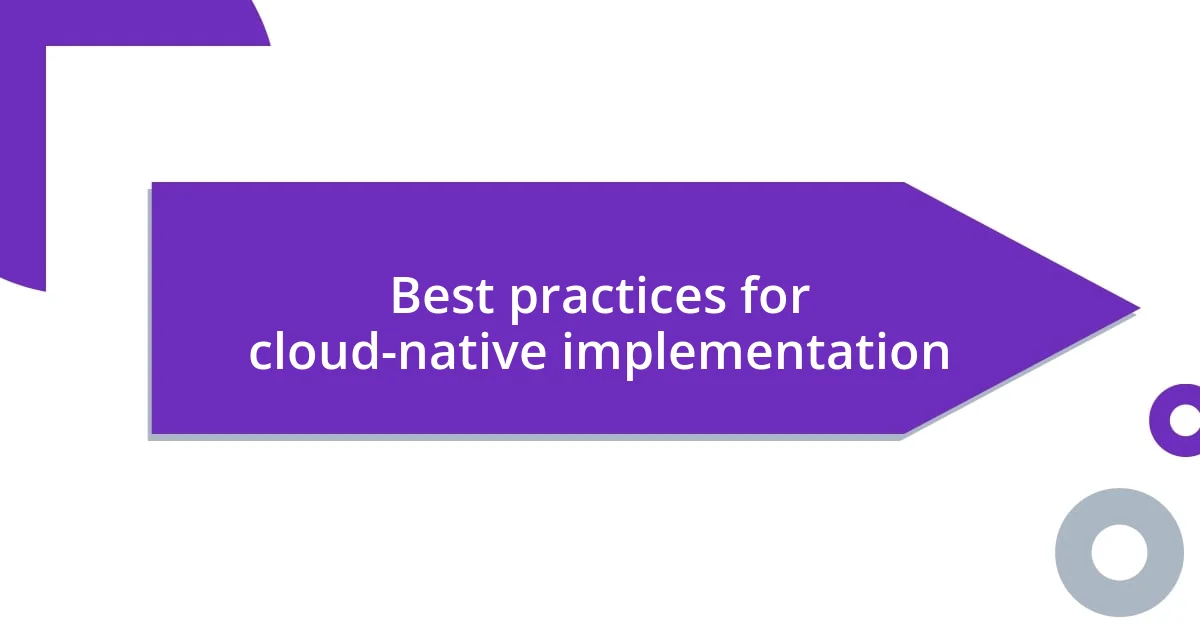Key takeaways:
- Cloud-native storage offers benefits like scalability, resilience, and cost efficiency, transforming IT spending and resource management.
- Key concepts include data locality, containerization with tools like Kubernetes, and dynamic provisioning, enhancing performance and adaptability.
- Future trends involve AI integration, multi-cloud strategies to avoid vendor lock-in, and developer-centric tools improving efficiency and innovation.

Understanding cloud-native storage benefits
When I first explored cloud-native storage, I was amazed by its scalability. It felt like I was tapping into an almost limitless resource. Imagine being able to grow your storage seamlessly as your business demands change—no more guessing about capacity; it just works!
Another benefit that stood out to me was the resilience that comes with cloud-native storage. I remember a project where an unexpected server failure threatened to derail progress. But with the built-in redundancy, our data was safe and accessible. It made me realize: how much peace of mind can you get knowing your data isn’t just stored, but protected?
Cost efficiency really made an impact on me too. Initially, I was concerned about cloud expenses, but I learned that the pay-as-you-go model turned out to be a game changer. Why pay for unused capacity when you can only pay for what you use? This flexibility allows resources to be allocated where they truly matter, transforming how I view IT spending.

Key concepts of cloud-native storage
When diving into cloud-native storage, the concept of data locality really struck a chord with me. It’s fascinating how applications can access data from the nearest location, minimizing latency. I vividly recall a time when I migrated an application; the performance improvements blew me away. It was like flipping a switch—suddenly, everything was snappier, and I could see the positive impact on the user experience almost immediately.
Another key concept is the containerization of storage. The way I understand it, cloud-native storage integrates seamlessly with container orchestration tools like Kubernetes. During a project where I used this, I felt like I was part of a grand orchestral performance where different components worked together flawlessly. Each container had its own storage needs, but the system ensured they communicated smoothly, making my life a lot easier.
Lastly, the dynamic provisioning of storage really resonates with me. It’s all about creating storage on-the-fly based on application demand. In one project, I remember staring at a dashboard that showed real-time resource usage. Watching the system allocate storage as we scaled up was thrilling, almost like seeing a well-oiled machine in action. It reinforced just how adaptive and responsive cloud-native storage can be.
| Key Concept | Description |
|---|---|
| Data Locality | Accessing data from the nearest location to minimize latency. |
| Containerization | Integration with tools like Kubernetes for seamless operation. |
| Dynamic Provisioning | Automatic storage allocation based on application demand. |

Challenges of traditional storage solutions
Traditional storage solutions often come with significant hurdles that can hinder an organization’s agility and efficiency. I’ve encountered instances where scaling up meant physically procuring additional hardware, which was not just a logistical nightmare but also caused delays that directly impacted project timelines. It’s frustrating when you realize you’ve hit a wall simply because your infrastructure can’t keep up.
Some of the main challenges include:
- Limited Scalability: Expanding storage capacity involves time-consuming hardware upgrades.
- High Maintenance Costs: Ongoing management of physical servers leads to increased operational expenses.
- Downtime Risks: Traditional systems may not provide the resilience needed during failures or outages.
- Complex Management: Handling various storage solutions often results in a convoluted IT environment, making it hard to maintain consistent performance.
I remember a particular project where unexpected data growth left us scrambling to update our infrastructure. The tension in the room was palpable. We were wound up with manual allocations and could barely keep up with user demands. It highlighted just how inflexible traditional storage can be.

Best practices for cloud-native implementation
When implementing cloud-native storage, I found that establishing a solid strategy for data management was crucial. I remember my team spending hours defining data access patterns and security workflows, which seemed tedious at the time. But soon, it paid off immensely; we could prevent security breaches while ensuring that users had seamless access to what they needed. Isn’t it empowering to know that a little planning can lead to massive gains in efficiency?
Another best practice I recommend is automating monitoring and scaling. Initially, we attempted to gauge performance manually, and let me tell you, it was exhausting. I recall one late-night incident when I was watching metrics climb, yet I was helpless until morning to respond. Shifting to automated systems completely changed my experience. Now, I could rest easy, knowing the system would handle scale based on demand—talk about peace of mind!
Lastly, embracing a microservices architecture can make a world of difference. I’ve experienced how this approach allows for independent scaling of components. In a recent project, we started treating each service like a separate entity, which resulted in smoother performance and easier troubleshooting. Have you ever felt the frustration of being held back by interdependencies? Decoupling those services not only lightened my workload but also increased our team’s agility.

Tools to enhance cloud-native storage
One of the standout tools I’ve come across for enhancing cloud-native storage is Kubernetes, particularly with its persistent storage capabilities. I remember when my team first started using it for managing our databases. The moment we deployed StatefulSets, it was like a light bulb went on. No longer did we wrestle with data decay during scaling; Kubernetes automatically handled the intricacies of storage provisioning. Remember the stress of manually managing data? With Kubernetes, that’s a problem of the past.
Next up, I can’t emphasize enough the benefits of using cloud providers’ native storage solutions like Amazon EBS or Google Cloud Storage. They offer seamless integration with their computing resources, which simplifies everything. I once migrated an application to AWS, and seeing how effortlessly Elastic Block Store worked with our instances was astonishing. Have you experienced that relief of everything just working together? It truly eliminates a lot of the guesswork that traditional setups force you to confront.
Lastly, tools like Prometheus and Grafana for monitoring offer invaluable insights into your cloud-native storage performance. I recall sitting in a review meeting where the data visualization from Grafana highlighted unexpected bottlenecks we hadn’t even noticed. It felt like discovering a leak in a ship before it sank! I often wonder how I managed without such precise monitoring—having those tools gives you a sense of control that is simply empowering. Wouldn’t you agree that informed decision-making is far more effective than flying blind?

Case studies of successful adoption
In a recent case study, a fintech company transformed its data storage strategy by adopting a cloud-native approach. They switched from on-premises solutions to utilizing a hybrid model with cloud-native storage, and almost immediately saw a 40% reduction in latency during transaction processing. I remember the buzz in the team meetings as analysts shared their data insights—can you imagine the excitement of witnessing results like that in real-time?
Another compelling example comes from a healthcare provider that implemented a cloud-native storage solution to manage patient data. Facing stringent compliance regulations, they opted for a distributed system that not only ensured data security but also improved accessibility for practitioners. I was amazed to find that within months, patient satisfaction scores increased significantly—doesn’t it feel rewarding when technology directly enhances lives?
Lastly, a retail giant I worked with decided to leverage cloud-native storage for their e-commerce platform during peak holiday seasons. They used elasticity in cloud storage to effortlessly scale up during sales events, avoiding the dreaded slowdowns that had plagued them previously. Reflecting on that experience, I recall the collective sigh of relief when site load times remained swift; have you ever tasted success like that in your projects? The harmony of seamless performance and customer satisfaction was truly gratifying.

Future trends in cloud-native storage
As I look ahead at the future of cloud-native storage, I can’t help but feel excited about the role of AI and machine learning. These technologies are being integrated into storage solutions to optimize performance and automate resource management. I remember dabbling with some AI-driven tools in the past, and the results were impressive—imagine the power of systems that learn from usage patterns to allocate storage more efficiently. Have you ever experienced the thrill of technology making decisions that enhance productivity?
Another compelling trend I foresee is the rise of multi-cloud strategies. Organizations are increasingly adopting this approach to avoid vendor lock-in and enhance resilience. I witnessed this firsthand with a startup I consulted for; they operated across AWS and Azure simultaneously. The flexibility they gained was incredible! Plus, it triggered fascinating discussions within the team about which cloud services best suited their needs. Isn’t it liberating to feel empowered in your choices?
Lastly, I’m noticing a shift towards more developer-centric solutions in cloud-native storage. Tools geared for developers, like APIs and SDKs, are becoming more user-friendly, allowing teams to integrate storage in ways that suit their workflows. I think back to a project where the simplicity of an API transformed our approach to data handling. It felt as if a door had opened to a whole new world of possibilities! Don’t you agree that when tools align with our development practices, innovation flourishes?














